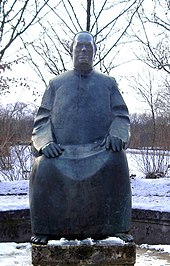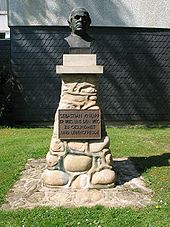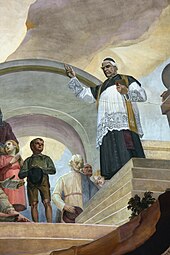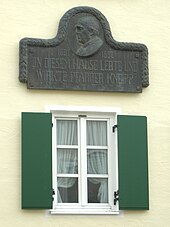Sebastian Kneipp
Sebastian Anton Kneipp (born May 17, 1821 in Stephansried in Upper Swabia , † June 17, 1897 in Wörishofen ) was a Bavarian Roman Catholic priest who became known as a hydrotherapist and naturopath who practiced cold water therapy . He is the namesake of the Kneipp medicine and the water cure with treading water , etc., which were used earlier, but only became popular through him.
Life
Childhood and adolescence
Sebastian Kneipp was born in the Bavarian-Swabian Stephansried (today part of Ottobeuren ) as the son of the weaver Xaver Kneipp and his wife Rosina. He had two sisters and two half-sisters. The family was poor, so that at the age of eleven he had to work at his father's loom or as a herder in the village. From 1827 to 1833 Kneipp attended the village school in Stephansried and from 1833 to 1839 the Sunday and public holiday school in Ottobeuren. After his parents' house burned down and his savings of 70 guilders were lost as a result, he left his hometown and found a job as a farmhand in Grönenbach . An extended relative, chaplain Matthias Merkle , took care of him, taught him Latin and thus prepared him for high school . In Grönenbach he also met the Evangelical Reformed local pastor and botanist Christoph Ludwig Köberlin , who introduced him to herbal medicine.
In 1844 Kneipp was accepted into the royal college in Dillingen . In 1848 he began to study theology at the Dillinger Lyzeum (from 1923 to 1971 Philosophical-Theological University of Dillingen ) .
The discovery of the hydrotherapy

By 1846 at the latest, Kneipp suffered from a lung disease, probably tuberculosis . In 1848 he accidentally discovered the book “Lessons from Power and Efficiency of Fresh Water in the Body of People…” by Johann Siegemund Hahn in a new edition by Eucharius Ferdinand Christian Oertel, published in three editions from 1833/34. Then Kneipp bathed two or three times a week, especially in 1849, for a few moments in the ice-cold Danube near Dillingen , took half baths at home, poured water over himself and, according to his own statements, got well again. In the latter city, the Kneipp fountain and Kneipp circular path are a reminder of the priest and practitioner of the water cure.
In 1850 Kneipp received a free place at the Georgianum in Munich and continued his theology studies there. Daily water applications had become an integral part of his life. At the Georgianum he secretly treated fellow students who had tuberculosis for the first time. He read books about water applications, visited the association of water lovers and heard there from Vincenz Prießnitz from Graefenberg , who had been treating with water in Austrian Silesia for 30 years .
On August 6, 1852 Bishop he gave Peter von Richarz in Augsburg Cathedral , the ordination . Until 1855 he had three positions as chaplain : in Markt Biberbach near Augsburg, Boos and St. Georg in Augsburg .
First resistance
In February 1853 the first complaint was made for quacking because Kneipp had treated a cholera maid with hot compresses. He was fined two guilders for "offenses against the courier ban". Ironically, he also issued the judge with a cure for gout .
In 1854 a pharmacist from Babenhausen in Swabia accused Kneipp of “impairing the business and damaging it”. Kneipp explained to the court that he had only ever treated people who, after years of treatment, found no help from doctors and pharmacists or who simply had no money to afford a doctor. Thereupon he had to sign a declaration, “no longer to help even those unfortunate people who allegedly could no longer find medical help”. In the same year a cholera epidemic broke out in Munich and spread throughout Upper Bavaria and Swabia . Kneipp's father was one of the first cholera victims in Stephansried. When the disease broke out in Boos, Kneipp acted against the cease and desist declaration. He was later credited with healing forty-two sick people. The vicar general at the episcopal ordinariate became aware and made inquiries about him. The population called Kneipp the "cholera chaplain". At the end of 1854 he was transferred to Augsburg .
Arrival in Wörishofen
In May 1855, Kneipp became confessor and chaplain in the Wörishofen Monastery of the Dominican Sisters , which is now a Kneipp museum. Under his influence, life changed there. He restored the Justinakirche , among other things rebuilt the monastery’s agriculture, which had been fallow since the secularization of 1802, and gave it a viable basis on behalf of the bishop. He himself designed a drainage system for wet meadows, introduced new types of clover and instructed the sisters in grafting trees and in beekeeping. Meanwhile, more and more people looking for help came to Wörishofen, increasingly also from wealthier circles.
Wörishofen becomes a health resort
In the following decade, there were more and more spa guests in Wörishofen during the summers. The local gastronomy gradually developed and inns were built. Because of his controversial methods, Kneipp was sued several times by conventional medicine.
When Wilhelm of Prussia became German Emperor in 1871 , Kneipp's friend and patron Merkle became a member of the Reichstag . In the meantime, rural exodus had also started in Germany . This prompted Kneipp to write his first book in which he broke a spear for agriculture.
In 1873, Merkle received a letter from Kneipp informing him that, with retroactive effect from January 1, 1873, courier exemption would also apply in Bavaria . However, medical associations and medical circles at universities opposed the new law, with Kneipp becoming the focus of this discussion. Despite the criticism, more and more spa guests came to Wörishofen.
In 1883, Bernhuber, a young doctor from Türkheim , came to Wörishofen and spoke to Kneipp, but remained skeptical. In 1884 he came again, this time with the request to be allowed to attend. Kneipp spontaneously offered him the collaboration, and Bernhuber agreed. They now led the daily consultation hours together.
At this time, Kneipp also wrote Meine Wasser-Kur , a revision of Heinrich Friedrich Francke's first description of the "Graefenberger Wassercur" by Prießnitz. The book was published in 1886, without Kneipp disclosing its original, and was to become a standard work . Kneipp's water cure was only discovered as a plagiarism in 1899, when it was already in its 65th edition.
In August 1889 there were 4,000 seekers of salvation in Wörishofen. So many guests came that some of them had to be accommodated in the surrounding villages. Kneipp wrote a second book entitled This is how you should live! . In the autumn of this year, Prince Rupprecht of Bavaria , who was in the maneuver as chief of the 10th regiment near Augsburg, had Kneipp pourings on him. He was followed by other nobles and high clergy.
More and more bathhouses were built in Wörishofen. In the summer of 1890 there were 6,000 guests in Wörishofen. Kneipp now gave daily public health lectures in which he spoke out against the modern, in his opinion disease-causing way of life.
On December 14, 1890, the publisher Ludwig Auer from Donauwörth founded the first Kneipp association. Kneipp himself became honorary president. Just one month later, Auer published the first edition of the Kneipp papers, which still appear monthly today (today: Kneipp-Journal, publisher Kneipp-Bund e.V. , Bad Wörishofen).
In December 1890, Mayor Birk, who was against the expansion of Wörishofen into a health resort, resigned from his office. His successor Augustin Huber was a supporter of Kneipp, so that the health resort was organized with the support of the local council. Sidewalks and a water pipe were created. Kneipp insisted vehemently on the establishment of a charitable department and attached importance to the fact that the poor sick and orphans should continue to be treated free of charge.
Kneipp is known all over Europe

In the next few years, Kneipp traveled almost all over Europe accompanied by Pastor Aloys Stückle. One of his trips took him to Hungary , where he treated Archduke Joseph of Austria and Hungary. It was then Archduke Joseph who a year later campaigned for Kneipp with the Pope in Rome .
In August 1892, Alfred Baumgarten arrived in Bad Wörishofen, who, with the approval of the Kneipp Association, was hired as a permanent spa doctor with a fixed salary and the obligation to treat poor patients free of charge.
Two months later, Prior Bonifaz Reile and the first Fathers and Brothers of the Brothers of Mercy from Neuburg arrived. The Brothers of Mercy now played an increasingly important role in supporting Kneipp. The Kurhaus Sebastianeum under the direction of Prior Reile developed more and more into the center of the spa business.
Kneipp held his office hours there in the Sebastianeum. In 1893, Wörishofen counted a total of 33,130 spa guests and over 100,000 “other visitors and passers-by”.
Honored by Pope and Patriarch
At the end of 1893, Kneipp was taken over by the Roman Catholic Pope Leo XIII. appointed papal secret chamberlain . The following year he traveled to Rome and received an audience with the Pope. He let himself be treated by Kneipp and gave him a gold medal as a farewell. The brother of Kneipp's closest collaborator, Alfred Baumgarten, the Papal Chamberlain Paul Maria Baumgarten (1860–1948), acted as guide and interpreter at the private audience.
Sebastian Kneipp was appointed Commander of the Knightly Order of the Holy Sepulcher in Jerusalem by the Latin Patriarch of Jerusalem .
Criticism and arson
In 1894 the International Association of Kneipp Doctors was founded under the chairmanship of Alfred Baumgarten . At the end of the year, Mein Testament was published in collaboration with Baumgarten . Despite all the successes, the hostility never stopped. There were several arson attacks in Wörishofen; they applied to the Kurhaus, the editorial staff of the Kneipp papers and other institutions. The press, especially the Augsburger Abendzeitung and the Leipziger Volkszeitung , sharply criticized Kneipp, accusing him of greed for profit and even neglecting the children entrusted to care .
The last few years
In the summer of 1894 Kneipp showed the first signs of weakness. He recovered and went on a lecture tour again in the fall of 1896. At the beginning of 1897, however, he was so attacked that he could no longer pour his water himself. A rapidly growing tumor was found in the abdomen that was pressing on the vessels. While he was sick in bed, the lay movement and the medical faction were already fighting over his inheritance. Kneipp himself now spent most of the time in his room and allowed himself to be treated with water applications. Numerous doctors came to him and examined him, but he refused the only helpful method, an operation. He died on June 17, 1897, at 4:30 a.m., at the age of 76. His funeral took place on June 26, 1897.
Effect after death

At the beginning of the 20th century, Kneipp was the best-known German after Bismarck in North America. Today in Germany there are over 600 Kneipp associations with around 160,000 members under the umbrella organization of the Kneipp Association . The books by Kneipp reached millions of copies and are still published today. In 1920 Wörishofen was awarded the title bathroom . In addition to Bad Wörishofen, there are other Kneipp health resorts in Germany . Even where Kneipp therapy is no longer used, names are often reminiscent of former Kneipp health resorts. So there is in Swedish Norrköping the district Kneipp bathing or Kneipp and outside Visby the leisure facility Kneippbyn .
In 1958, the director Wolfgang Liebeneiner filmed the life of Kneipp under the title Sebastian Kneipp - the water doctor , with well-known actors such as Carl Wery , Paul Hörbiger and Gerlinde Locker .
On December 4, 2015, the German UNESCO Commission announced that Kneipp therapy as "traditional knowledge and practice according to the teachings of Sebastian Kneipp" had been included in the nationwide register of intangible cultural heritage.
Since 2010, Sebastian Kneipp's birthday has been run under the name Sebastian Kneipp Day as a health day at the Federal Center for Health Education .
In 1975 a bust of Kneipp was placed in the Munich Hall of Fame . It was created by the Bad Wörishofer sculptor Konrad Ledermann (1905–1983).
To mark the 200th birthday gave German Post AG with the initial issue an April 1, 2021 special stamp in the denomination out of 155 euro cents. The design comes from the graphic artist Veit Grünert in Berlin.
Museums
There is a Kneipp museum in Bad Wörishofen, as well as in Bad Endbach (Hesse).
Publications
- My water regimen. Kempten 1886 ( 49th edition, full text online ; 54th edition Kempten 1894).
- This is how you should live. Kempten 1889 (6th edition, ibid. 1890).
-
Memories from my life. In: Kneipp leaves. 1881 and 1921.
- Volume 1, 1891, No. 2-9, pp. 25-27, 43-45, 57 f., 74 f., 86 f., 107 f., 118-120 and 139-141.
- My life. Regensburg undated, reprint Johann von Gott, 1954.
- Out of my life. Reprint of the editions from 1891 and 1921 with unchanged text, ed. from the Stamm-Kneippverein e. V. Bad Wörishofen, Bad Wörishofen 1979.
- My testament for the healthy and the sick. 22nd edition, Kösel, Kempten et al. 1912. Digitized edition of the University and State Library Düsseldorf .
- Codizill to My Testament for the healthy and the sick. Jos. Kösel'sche Buchhandlung, Kempten 1896.
- Child care on healthy and sick days. Donauwörth 1890.
- Advice for the healthy and the sick. Donauwörth 1891.
Miscellaneous
A rose , at least one bridge and also medicines bear his name or, for licensing reasons, only his likeness.
The Pfarrer Kneipp elementary and middle school in Bad Wörishofen was named “Pfarrer Kneipp” .
Movies
- Sebastian Kneipp and his time , BR 1997, a film documentary by Bernhard Graf
- Acquittal for the "water doctor". The Kneipp processes and their consequences , BR 1998, a film documentary by Bernhard Graf
- Sebastian Kneipp - A great life , Austria 1958, 117 min, director: Wolfgang Liebeneiner (also available on DVD under the title: Sebastian Kneipp - Der Wasserdoktor )
literature
- Isa-Maria Betz: Wörishofen becomes a world bath. Dr. Alfred Baumgarten 1862–1924 . Anton H. Konrad Verlag, Weißenhorn 2011, ISBN 978-3-87437-476-7 .
- Alfred Brauchle : The second high point in the development of hydrotherapy and a no less great success. the pastor Sebastian Kneipp. the public health teacher. In: the same: History of naturopathy in life pictures . 2nd ext. Ed. By Große Naturärzte . Reclam-Verlag, Stuttgart 1951, pp. 133-157
- Joachim Frucht: Kneipp, Sebastian. In: New German Biography (NDB). Volume 12, Duncker & Humblot, Berlin 1980, ISBN 3-428-00193-1 , p. 174 f. ( Digitized version ).
- Harald Klofat: Idea, conviction and teaching. Sebastian Kneipp - the Wörishofer years. Franz Brack Verlag, Altusried 2009, ISBN 3-930323-82-6 .
- Antonie Mayer: The Kneipp family , CA Starke-Verlag, Limburg / Lahn 2009, ISBN 978-3-7980-0582-2 .
- Eugen Ortner : Sebastian Kneipp - His life story , Ehrenwirth Verlag, 12th edition 1994, ISBN 3-431-02659-1 .
- Otto Gerhard Prokop : Sebastian Kneipp, the great "naturopath" and the associated realities in: Limits of tolerance in medicine . Verlag Gesundheit, Berlin 1989, ISBN 3-333-00487-9 .
- Eckart Roloff : Sebastian Kneipp: Through five pillars to the apostle of health for body and soul. In: Eckart Roloff: Divine flashes of inspiration. Pastors and priests as inventors and discoverers . Wiley-VCH, Weinheim 2010, ISBN 978-3-527-32578-8 , pp. 235-253; 2nd updated edition 2012 (paperback) ISBN 978-3-527-32864-2 (with references to places of remembrance, monuments, museums, associations, streets, prizes, medals, etc.).
- Bernhard Uehleke: Kneipp, Sebastian. In: Werner E. Gerabek , Bernhard D. Haage, Gundolf Keil, Wolfgang Wegner (eds.): Enzyklopädie Medizingeschichte. De Gruyter, Berlin / New York 2005, ISBN 3-11-015714-4 , p. 766.
- Joachim Jahn : Kneipp, Sebastian. In: Karl Bosl (ed.): Bosls Bavarian biography. Pustet, Regensburg 1983, ISBN 3-7917-0792-2 , p. 427 ( digitized version ).
- Hans-Michael Körner (Ed.): Large Bavarian Biographical Encyclopedia . De Gruyter Saur, Berlin / New York 2005, Reprint 2010, p. 1042
See also
Web links
- Literature by and about Sebastian Kneipp in the catalog of the German National Library
- Works by and about Sebastian Kneipp in the German Digital Library
- This is how you should live! in Project Gutenberg ( currently usually not available for users from Germany )
- Kneipp Association e. V. Kneipp umbrella organization
Individual evidence
- ↑ Original spelling based on a facsimile print in the new edition of Kneipp - From my life , published by the Stamm-Kneipp-Verein, Bad Wörishofen 2012.
- ↑ Bernhard Uehleke : Bad Wörishofen and Sebastian Kneipp 100 years ago. In: Würzburg medical history reports. Volume 14, 1996, pp. 441-447, here: p. 441.
- ^ Gundolf Keil : Vegetarian. In: Medical historical messages. Journal for the history of science and specialist prose research. Volume 34, 2015 (2016), pp. 29–68, here: p. 42.
- ^ Friedrich Oertel: An old water doctor. In: Kneipp leaves. Volume 1, No. 13, 1891, pp. 193-195, here: p. 194.
- ^ Kneipp Museum Bad Wörishofen - The life of Sebastian Kneipp
- ↑ JH Rausse : The spirit of the Graefenberger water cure. Zeitz 1838 ( digitized 2nd edition, 1839).
- ^ Gundolf Keil: Vegetarian. In: Medical historical messages. Journal for the history of science and specialist prose research. Volume 34, 2015 (2016), pp. 29–68, here: pp. 42–46.
- ↑ See also Ernst von Held-Ritt: Prißnitz on Graefenberg or faithful representation of his healing process with cold water. Mörschner and Jasper, Vienna 1837, especially p. 14.
- ↑ Hubertus Averbeck: From the cold water cure to physical therapy. Reflections on people and at the time of the most important developments in the 19th century . Europäische Hochschulverlag, Bremen 2012, ISBN 978-3-86741-782-2 , pp. 229 and 999.
- ↑ Wolfgang Uwe Eckart: Illustrated history of medicine. From the French Revolution to the present . Springer, Berlin 2010, p. 66.
- ↑ a b "Sebastian Kneipp" , Ottobeuren parish, accessed on February 19, 2012
- ^ Bernhard Uehleke : Kneipp, Sebastian. In: Werner E. Gerabek et al .: Encyclopedia of Medical History. 2004, p. 766.
- ↑ Kneippen is an intangible cultural heritage . ( kneippbund.de [accessed on May 27, 2018]).
- ^ Google Books . Retrieved May 28, 2018.
- ↑ http://www.kneippmuseum.de/home.html
- ↑ Eckart Roloff and Karin Henke-Wendt: Visiting Pastor Kneipp, the water doctor. (The Kneipp Museum Bad Wörishofen) In: Visit your doctor or pharmacist. A tour through Germany's museums for medicine and pharmacy. Volume 2, Southern Germany. Verlag S. Hirzel, Stuttgart 2015, pp. 93-95, ISBN 978-3-7776-2511-9 .
- ↑ Bad Endbach | HOME. Retrieved September 14, 2020 .
- ↑ Eckart Roloff and Karin Henke-Wendt: A whole village for Pastor Kneipp. (The Kneipp Museum Bad Endbach) In: Visit your doctor or pharmacist. A tour through Germany's museums for medicine and pharmacy. Volume 2, Southern Germany. Verlag S. Hirzel, Stuttgart 2015, pp. 169-171, ISBN 978-3-7776-2511-9 .
- ^ Website of the pastor's Kneipp primary and secondary school .
| personal data | |
|---|---|
| SURNAME | Kneipp, Sebastian |
| ALTERNATIVE NAMES | Kneipp, Sebastian Anton (full name) |
| BRIEF DESCRIPTION | Bavarian priest and hydrotherapist |
| DATE OF BIRTH | May 17, 1821 |
| PLACE OF BIRTH | Stephansried |
| DATE OF DEATH | June 17, 1897 |
| PLACE OF DEATH | Woerishofen |









